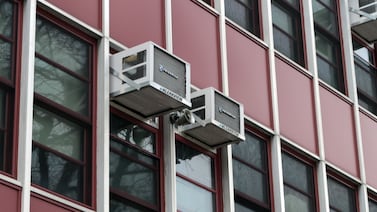Sign up for Chalkbeat New York’s free daily newsletter to keep up with NYC’s public schools.
Myrna Mangual, a parent coordinator at P.S. 35 in the Bronx, hears from at least 10 parents a week who are confused about how to access pandemic food benefits.
The benefits — known as the Pandemic Electronic Benefit Transfer, or P-EBT — went out to all public school families and others in New York City, with several installments issued since 2020. Intended to cover the costs of meals usually provided for free at school, the funds have been praised by advocates, who have called the program a lifesaver for many of the city’s struggling families.
But for some of the parents Mangual works with, the money hasn’t been easy to use.
Those families aren’t alone, as tens of millions of dollars in potential New York City benefits remain unused. In the city, families of at least 90,000 eligible children had not redeemed a recent allotment of the pandemic food benefits as of last month, according to state data previously shared with Chalkbeat.
Those funds, which total at least $35 million, could begin to expire after December if they continue to go unspent.
Some families at P.S. 35 never received their state-issued P-EBT cards, while others say they didn’t see certain disbursements added to their accounts. When calling the state’s P-EBT helpline, some parents say they’ve had trouble reaching anyone who can provide assistance, often stumbling on the automated responses or experiencing long wait times to speak to an agent, before eventually turning elsewhere for answers.
Mangual, however, said she doesn’t know how to help the families at her school — where more than 95% of students come from low-income backgrounds and nearly a quarter are English-language learners, according to city data. She said she’s never received training on how to guide families through using the benefits.
“This is where my frustration comes from,” she said. “We know nothing.”
In total, New York’s Office of Temporary and Disability Assistance, or OTDA, has issued $6.3 billion in P-EBT benefits, with about 60% going directly to SNAP households with existing EBT accounts, while others received the funds on state-issued P-EBT cards.
The state maintains detailed P-EBT information on its website and operates a phone helpline at 1-833-452-0096. OTDA officials said they’ve provided information on each phase of the benefits to the state’s Education Department, which then distributed that information to local school districts.
The city’s Education Department said it has promoted information about the benefits on its website as well as on social media, and referred families with questions to OTDA.
Still, parents, schools, and community organizations say there’s been a disconnect, and many families aren’t receiving the information they need to take advantage of the benefits. Difficulties accessing the funds come as the need for them is especially high.
Nearly 75% of New Yorkers felt it was harder to afford groceries than a year prior, while more than half worried they would be unable to pay their food costs if faced with an unexpected $500 expense, according to a survey conducted by No Kid Hungry New York in April.
Stephanie Wu Winter, a senior program manager for No Kid Hungry, stressed the urgent need for the benefits.
“We’re glad these programs are being stood up and recognize it’s no small task to administer them,” she said in a statement. “But there’s a clear opportunity to increase outreach to families and give them direct lines of communication to understand what benefits they’re eligible for and when they’ll receive them. There’s time to get this right, but only if we move quickly.”
Education consultant David Rubel wants to see ramped up publicity before it’s too late, fearing the unspent money could be roughly $46 million across the two most recent disbursements.
“Parents did not know they had more P-EBT dollars coming due to minimal publicity,” said Rubel, who obtained the data on unused benefits through a public records request.
Families say it’s hard to get help
Carol Jackson, a Queens parent, said she received a text message in July notifying her that she’d soon receive a P-EBT card in the mail, but it never arrived.
As a SNAP recipient at the time, she should have seen her P-EBT benefits added directly to her existing account, but Jackson added she wasn’t sure whether the benefits were ever provided there, either.
She tried calling the helpline, but couldn’t get through to an agent, she said.
Meanwhile, Lynn Lu, a Manhattan parent and professor at the CUNY School of Law, said she experienced difficulties accessing the benefits last year on one of her children’s P-EBT cards, after they switched schools. She tried calling for assistance to check the balance on the card or figure out how to get it replaced, but wasn’t able to get a clear answer.
As part of her work at CUNY, she teaches a law school clinic where they represent clients in maintaining public assistance, like SNAP. But even as a member of listservs discussing such benefits, Lu said she was only “dimly aware” that another disbursement of P-EBT funds had rolled out this fall.
“It does raise this question of: How is word getting out to the general public?” she said, adding she couldn’t recall her children’s schools ever saying anything about the pandemic food benefits.
All families with valid phone numbers on file with their school district should receive a text message whenever new benefits become available, according to state officials. But some families said they never received such messages, even if they got initial notifications about their P-EBT cards.
In a statement, Anthony Farmer, a spokesperson for OTDA, said the agency has “worked tirelessly” to distribute the benefits to millions of residents across the state.
“The agency also conducted extensive public outreach and worked closely with advocacy organizations across the state to ensure eligible families are aware of these benefits and could take steps to redeem them,” he said.
More recent allotments will continue to be sent out to families through the end of December — including the at least $391 per child sent out for the summer of 2022 and the 2021-22 school year, as well as the $120 per child distributed for the summer of 2023 — according to OTDA.
One school reports widespread issues
Officials at the Lexington School for the Deaf in Queens say families at the school have not received P-EBT funds since the first disbursement in 2020. The school, which receives free meals through the city’s Education Department, serves students who are deaf from across the five boroughs.
Lori Glick, a social worker at the school, said families desperately need the extra support.
“There’s not enough food at home,” she said. “From the minute the announcement is made, they’re waiting for this money.”
State officials did not comment on the school’s specific situation, but said that not all children were eligible for all phases of P-EBT. For example, some of the allotments were based on COVID-related absences during the school year. Officials urged families with questions to call the P-EBT helpline.
Staff at the school said they remain unsure why families haven’t received more recent allotments of benefits.
“Honestly, it makes it look like we’re not doing something,” said Laura Cruz, the school’s director of pupil personnel services. “The families, they work with us, but then they get a little frustrated like, ‘What is Lexington not doing?’ And I don’t know if there’s something that we’re not doing.”
Community organizations report language barriers, other challenges
Both the P-EBT helpline and OTDA website offer information in languages other than English. Callers to the helpline can receive assistance from either an agent who speaks their native language or through an interpreter, while information posted online can be translated via a function at the bottom of the webpage, officials said.
But for some families with limited proficiency in English, using the benefits remains a constant struggle, said Wei Zhang, a program supervisor at the Chinese-American Planning Council.
Zhang works primarily with Chinese American families in Brooklyn who have children with disabilities and who have faced unemployment or been limited to part-time work since the onset of the pandemic. Many parents that he works with speak little English, making it hard for them to seek out help.
There’s been consistent confusion about how to activate P-EBT cards, how to use the benefits, and when more funds will be added, said Zhang, who has had to translate information about the benefits for families.
P-EBT can be particularly essential for those who earn just enough to be ineligible for SNAP benefits, added Mary Soriano and Sindy Rivera, senior case managers at WHEDco, a community development organization in the south Bronx.
“Pretty much all of their income is going towards rent, utilities, or child care,” Soriano said of the families they work with. “The pandemic EBT, as well as regular SNAP benefits, is what helps them feed their family — their children — every single day.”
But the vast majority of families they work with speak limited English, and some do not have consistent access to phones or computers, further complicating their ability to learn about and access their benefits.
Confusion surrounding the benefits has also been exacerbated by scams intended to steal them, like skimming or phishing, Zhang said. He’s seen families in Brooklyn lose their P-EBT benefits to such scams.
State officials have advised all EBT card holders, including P-EBT cardholders, to “remain vigilant” about potential scams. Taking basic precautions — like carefully inspecting point-of-sale devices, changing PINs regularly, and reviewing transaction history often — can help protect the benefits.
While the state received federal approval to replace stolen SNAP benefits in some circumstances earlier this year, P-EBT benefits are not eligible for replacement under federal guidelines, officials said.
Other states face P-EBT distribution issues
New York isn’t the only state to face hurdles in getting families to spend the federal benefits. In Maine, distribution of P-EBT cards this year spurred confusion among families and some school administrators. In California, nearly $1 billion in benefits remained unspent as of July. Meanwhile, in Mississippi, more than 14,000 families had their cards deactivated by mistake in 2021.
Benefit scams, too, have occurred across the country.
Though some families in New York City have encountered difficulties, most stress the benefits remain important.
Mangual, the parent coordinator, said she wished there were more avenues for parents to seek help. If schools had a point person to turn to for answers within their district, for example, it would be far easier to assist families, she said.
To Lu, the Manhattan parent, one of New York’s strengths during the pandemic was a pre-established “expectation that everyone is going to be able to get nutrition assistance through school, without any stigma.”
“That message is great,” she said. “But even when you do something helpful, there’s still going to be glitches.”
Julian Shen-Berro is a reporter covering New York City. Contact him at jshen-berro@chalkbeat.org.





